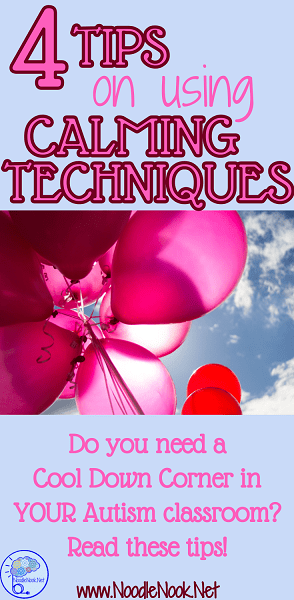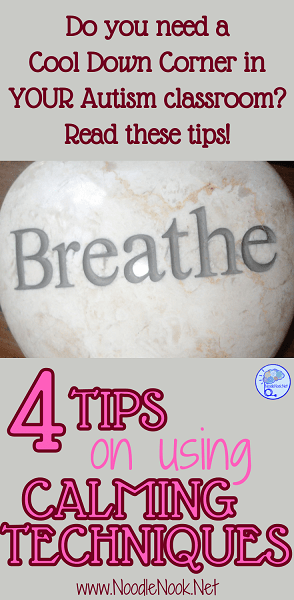Calming Techniques for Students with Autism
Saying “Calm Down” to a student with Autism may get you the result you want… a calm and receptive kiddo. BUT, it could get you nada. As you work with students who need help with calming down and calming strategies, here are a few calming techniques for students with Autism.
First off, I have to say that having a calm down corner or calm down sequence for students who are challenged with controlling their behaviors in the classroom is nearly a non-negotiable. You absolutely have to have an area in the classroom that is reserved for going through the calming sequence. There is so much to be said about a physical cue to signal the start of a calming sequence and transitioning into a calming area can help do that. It also helps you as a classroom teacher to have a space in the classroom with all the physical tools you need to start, work through, and end the calming sequence. In that area, you can store visuals, timers, and physical tools all ready to go!
Secondly, I know you are all jazzed about calming sequences and techniques, but be sure you remember you will have to teach a student how to get into a calming corner, what to do once they’re there, and how to get out of it. All that is NOT intuitive in a classroom of students with significant disabilities- you will have to directly teach it.
Thirdly, remember all the steps to a good calming strategy. Read more…
Tip #1: Learning to Identify Emotions
This sounds like a weird place to start, but the first step in an Autism unit to teaching calming techniques is actually helping students to identify emotions in the first place. You may end up knee deep in a tantrum or behavior and all along your student may not even know the emotion they’re feeling.
Being able to identify emotions becomes important because,as a student works through a calming technique, they really need to know what emotion they are feeling so they can learn to see it coming and also choose the right calming technique. What a student chooses to help them work through anxiety will look different than working through sadness or stress.
At the same time, you also want to teach intensity of emotions. Is a student at a 1 or a 10? Because that may change the coping tool used… so you want to teach intensity too. This helps as a mental marker as well to work on emotion identification even when a student isn’t overwhelmed with how they are feeling. You’ll want to work on it when a student is calm. A little agitated, and fully ramped up. The identification of intensity and emotions shouldn’t only be when a student is in crisis.
Tip #2: Learning Calming Techniques
These tips are tips and not steps because they are non-sequential. You can start with this tip for calming techniques. I think this is the fun part- actually defining the techniques you’ll use to calm a student! Okay… it made me excited, but it may make you feel stressed. There are so many things you can choose from for calming. Here are a few ideas that are easy to start with and work for most:
-Take A Deep Breath
-Count to Ten
-Use Positive Visualization
-Repeat a Positive Message
-Squeeze a Stress Ball
-Shake a Sensory Bottle or Calm Down Jar
-Take a Break (Calm Down Corner)
-Journaling or Drawing How You Feel
These a a few ideas, but there are tons more. I love this Freebie from Liz’s Early Learning Spot, so check it out here. You can also score another Freebie from Fun for Learning with their Calm Down Starter Kit here.
Finally, if you are interested in making a DIY Calm Down Jar, click over to my Pinterest page and follow the Behaviors and Social Skills board. You’ll find several, including a few of my favorites!
Tip #3: Teaching Self-Talk
This may sound weird, but you will have to take time to teach some self-talk! First, what is self-talk? As crazy as it sounds to say out loud, you have all kinds of conversations with yourself in your head. All kinds! As easy as it is to dismiss the chatter as crazy talk… it is actually a very sophisticated way for you to problem solve, work out issues, and think analytically. We ask ourselves questions, work out options, and practice what we are going to day all in that ‘crazy’ self-talk.
So, when it comes to students with Autism or other low-incidence disabilities including intellectual disabilities, we have to model what self- talk sounds like as a way of modeling coping techniques, problem solving, and social narratives.
An example of this, and a whole self-talk conversation I had tonight, was as follows:
…in my head: “what the heck am I going to make for dinner? I could make that crock pot thing. I would have had to have started that already. What do I want to eat? Oi. What will the kids eat? Forget it. I’m ordering pizza. Do I have a coupon?” I get up and start looking for a coupon “forget a coupon. I’m just gonna warm up the leftovers from three days ago.” I look in the fridge. “Who ate all the leftovers?” Me deciding chips for dinner is perfectly acceptable. I smile.
Okay. Now you know I fed my kids chips for dinner because pizza was too hard. Don’t judge.
In the classroom when it comes to teaching self-talk, a lot of that is related to modeling what it looks and sounds like. You will feel like you are talking to yourself a whole lot, but what you are really doing is showing what talking to yourself looks and sounds like when you are solving problems. You are also modeling when you take actions and when you calm yourself.
So, in practice, it might look like me saying this so my student can hear me: … “I am in the calm down corner. I had to come here because my skin was hot and I felt like crying- I am feeling mad. I wanted to hit someone or hit myself. I don’t do that. I can calm down another way. I am going to shake this bottle hard and watch the glitter fall down. When it is all down, I will see how I am feeling.” Then ask the student “How do you feel?”
You may also need to provide self talk phrases like
“It’s okay.”
“Stay calm.”
“I think I need a break.”
Tip #4: Model and Practice
If you read any other posts about behavior on my blog, I bet you know what I am about to say… model, model, model and practice, practice, practice! You will have to model the target behavior and calming strategy over and over for your students to learn it as well as have them practice when they are not in crisis.
In order to practice the process of calming down, you will have to be sure your student clearly knows when they need to calm down, how to calm down, and what to do once they have calmed down. If you have a cool down spot or calm down corner, students will also have to learn the procedure for how to get into the area, what to do once they are there, and how to get out of it and return back to work/group/class.
Putting It All Together
Calm down corners or cool down spots are not for every student, but most students in self-contained do benefit from having some reliable calming techniques. Every student can take time to learn how to use some good calming techniques, so don’t be afraid to teach emotions, intensity, and calming to all your students and then take that extra step to implement the cool down spot for those who would benefit most.
So set up that spot, stay strong and teach on!





